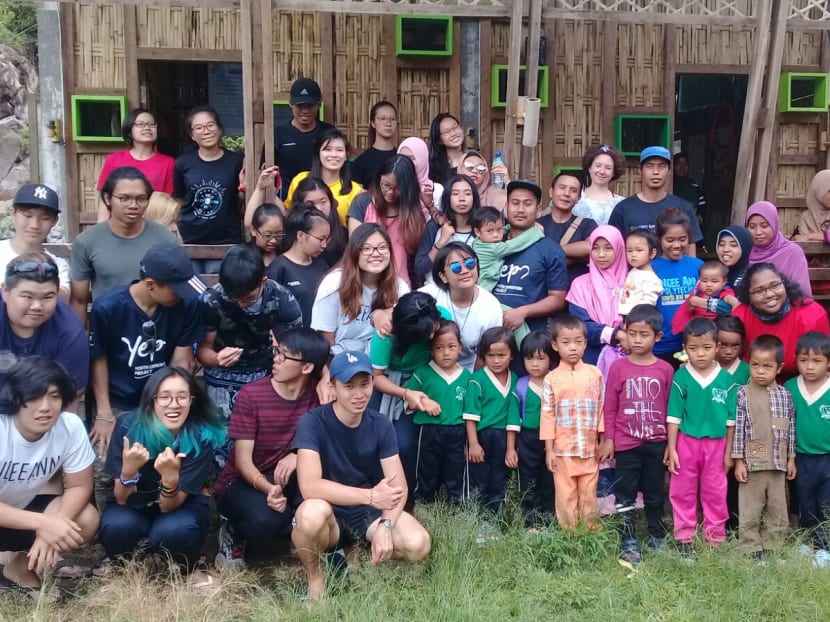Ngee Ann Poly raises S$20,000 for Lombok villagers affected by earthquakes
SINGAPORE – A group of lecturers from Ngee Ann Polytechnic (NP) have helped raise about S$20,000 since Monday (Aug 6) for Lombok residents, after two major earthquakes recently rocked the Indonesian island.

After years of visiting two villages in east Lombok as part of a Youth Expedition Project (YEP), some Ngee Ann Polytechnic lecturers and students have developed strong bonds and friendships with the locals there.
SINGAPORE – A group of lecturers from Ngee Ann Polytechnic (NP) have helped raise about S$20,000 since Monday (Aug 6) for Lombok residents affected by the major earthquakes that recently rocked the Indonesian island.
The sum is double the S$10,000 target, which they had initially hoped to reach by Sept 3.
For them, news of the disaster hit close to their hearts. After years of visiting two villages in east Lombok as part of a Youth Expedition Project (YEP), they had developed strong bonds and friendships with the locals.
The teachers — as well as students who went on the yearly trips — kept in touch with the locals through social media and messaging platforms, such as WhatsApp and Instagram.
When the first 6.4-magnitude earthquake hit on July 29, the Singaporeans reached out to them in concern, NP lecturer Raja Mohammad Fairuz told TODAY.
The 39-year-old visited the villages of Sembalun Lawang and Sembalun Bumbung almost every year from 2014 to 2017, usually with about 20 to 30 students in tow.
“It was a very good experience over four years. We built very strong bonds with the locals from going back there repeatedly… we stayed in their homes, conducted programmes with the local children,” he added.
NP graduate Katherine Tay, 21, who went on the YEP trip to Sembalun Lawang last year, said that she and most of her friends keep in contact with the locals on Facebook and Instagram.
Through homestays, they got to live with and interact with the villagers. Twenty of the locals volunteered to build a kindergarten in the village alongside the NP students as well.
“They looked out for us and we got to know each other,” she added.
HELP NEEDED
Mr Raja started receiving WhatsApp updates from the villagers after the first quake on July 29.
While the first earthquake caused some damage to buildings in Sembalun Lawang and Sembalun Bumbung, the 6.9-magnitude one that followed on Sunday (Aug 5) caused most homes and buildings there to completely collapse, leaving little shelter for refuge.
Ms Tay said she received a text message on Friday saying 90 per cent of Sembalun Lawang was damaged, as it was close to the epicenter of the second earthquake.
The death toll across the island now stands at 347, after a 6.2-magnitude aftershock struck on Thursday afternoon.
Shortly after the first quake, Mr Raja started planning a campus-wide donation drive with two fellow NP staff members, which is slated go on for another month till Sept 3.
Through emails to students and faculty - with a QR code to scan and donate through cashless apps - the teachers had initially targeted to raise S$10,000 over the duration of the donation drive.
The response so far has been “very encouraging”, Mr Raja said, nearly doubling the amount in less than a week.
The proceeds will go towards buying relief supplies and financing rebuilding of key infrastructure using locally-sourced materials that are earthquake-resistant.
“We are still in discussions on what the best form of aid is for the locals,” he added. “We are also looking to go for a recce trip to do a proper risk assessment, and see how we can help restore schools that have been damaged… restore normalcy.”
But Mr Raja said that the villagers’ access to clean water, medication and shelter has been severely limited, resulting in a recent outbreak of diarrhea.
Moreover, temperatures dip at night in the mountains, sometimes to below 20°C.
“The rainy season is coming too,” he added. “They ask for blankets to keep warm, tarpaulins, food, medicine. Maybe more aid is focused in north Lombok (which was worst-hit by the first earthquake) at the moment, so they still need help.”
For now, Mr Raja said that he is personally more interested in figuring out how to help the villages to redevelop for the long-term.
“Even though they’re already suffering on their own, they are rallying together to help each other out. I hope they can get stability,” he added.








